The MyDigitalSSD SBX SSD Review: NVMe On The Cheap
by Billy Tallis on May 1, 2018 8:05 AM ESTMixed Random Performance
Our test of mixed random reads and writes covers mixes varying from pure reads to pure writes at 10% increments. Each mix is tested for up to 1 minute or 32GB of data transferred. The test is conducted with a queue depth of 4, and is limited to a 64GB span of the drive. In between each mix, the drive is given idle time of up to one minute so that the overall duty cycle is 50%.
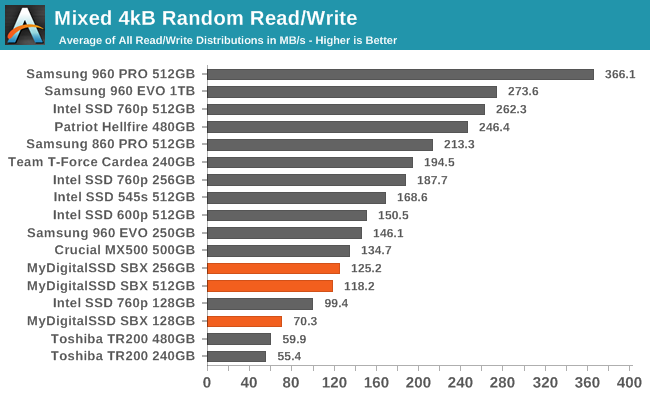
The mixed random I/O performance of the MyDigitalSSD SBX is worse than mainstream SATA drives and all of the NVMe competition. The 512GB SBX even manages to be a bit slower than the 256GB model.
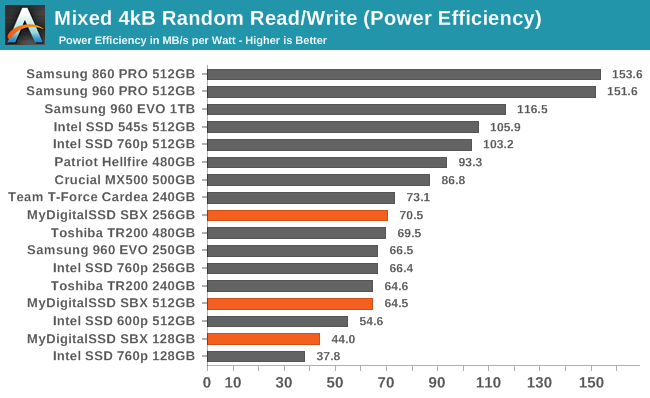 |
|||||||||
| Power Efficiency in MB/s/W | Average Power in W | ||||||||
Despite poor performance, the larger two capacities of the SBX have reasonable power efficiency on the mixed random I/O test, and the smallest is at least more efficient than the Intel 760p. Looking at power consumption in absolute terms, there is a clear gap between all of the PCIe x4 drives using at least 2.2W and the SBX topping out at 1.8W.
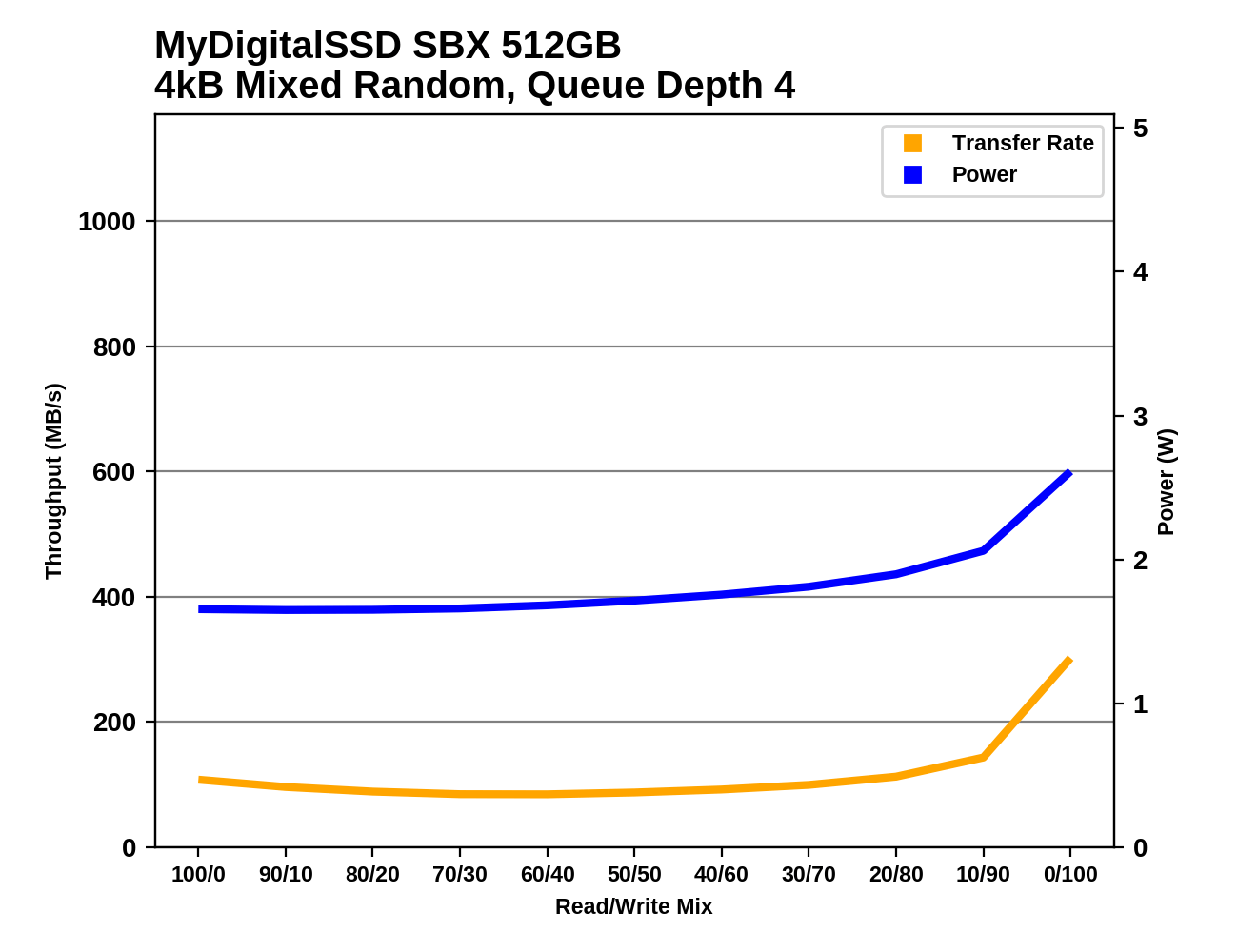 |
|||||||||
The shape of the performance curves for the SBX on the mixed random I/O test is typical: performance is low and mostly flat or slightly U-shaped for most of the test, then a clear increase in performance as the workload approaches pure random writes. That late boost in performance during the most write-heavy phases of the test is much smaller for the SBX than most high-end drives, and it isn't able to surpass the limits of SATA SSDs.
Mixed Sequential Performance
Our test of mixed sequential reads and writes differs from the mixed random I/O test by performing 128kB sequential accesses rather than 4kB accesses at random locations, and the sequential test is conducted at queue depth 1. The range of mixes tested is the same, and the timing and limits on data transfers are also the same as above.
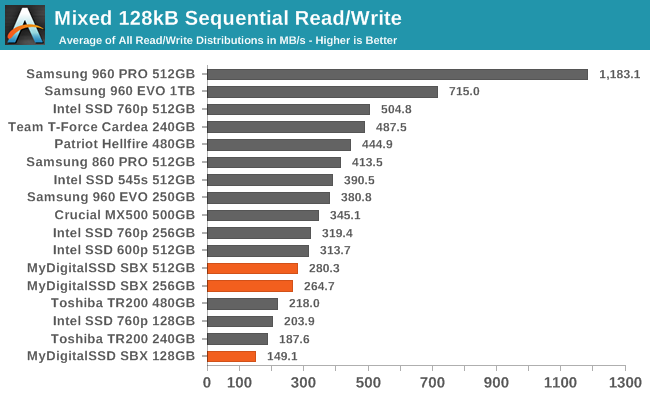
As with the mixed random I/O test, the performance results for the mixed sequential test put the MyDigitalSSD SBX below the current crop of mainstream SSDs and below all the other NVMe SSDs in this comparison—though the latter result is more or less expected. It's disappointing to see even the Intel 600p outperform the SBX.
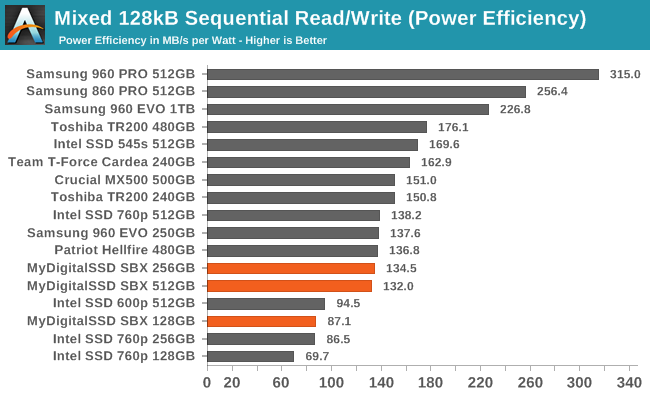 |
|||||||||
| Power Efficiency in MB/s/W | Average Power in W | ||||||||
The power efficiency from the MyDigitalSSD SBX is low, but only the 128GB model stands out as being well below average, and it is at least joined at the bottom of the charts by several Intel drives. As usual, the absolute power draw of the SBX is more typical for a SATA drive than a NVMe drive.
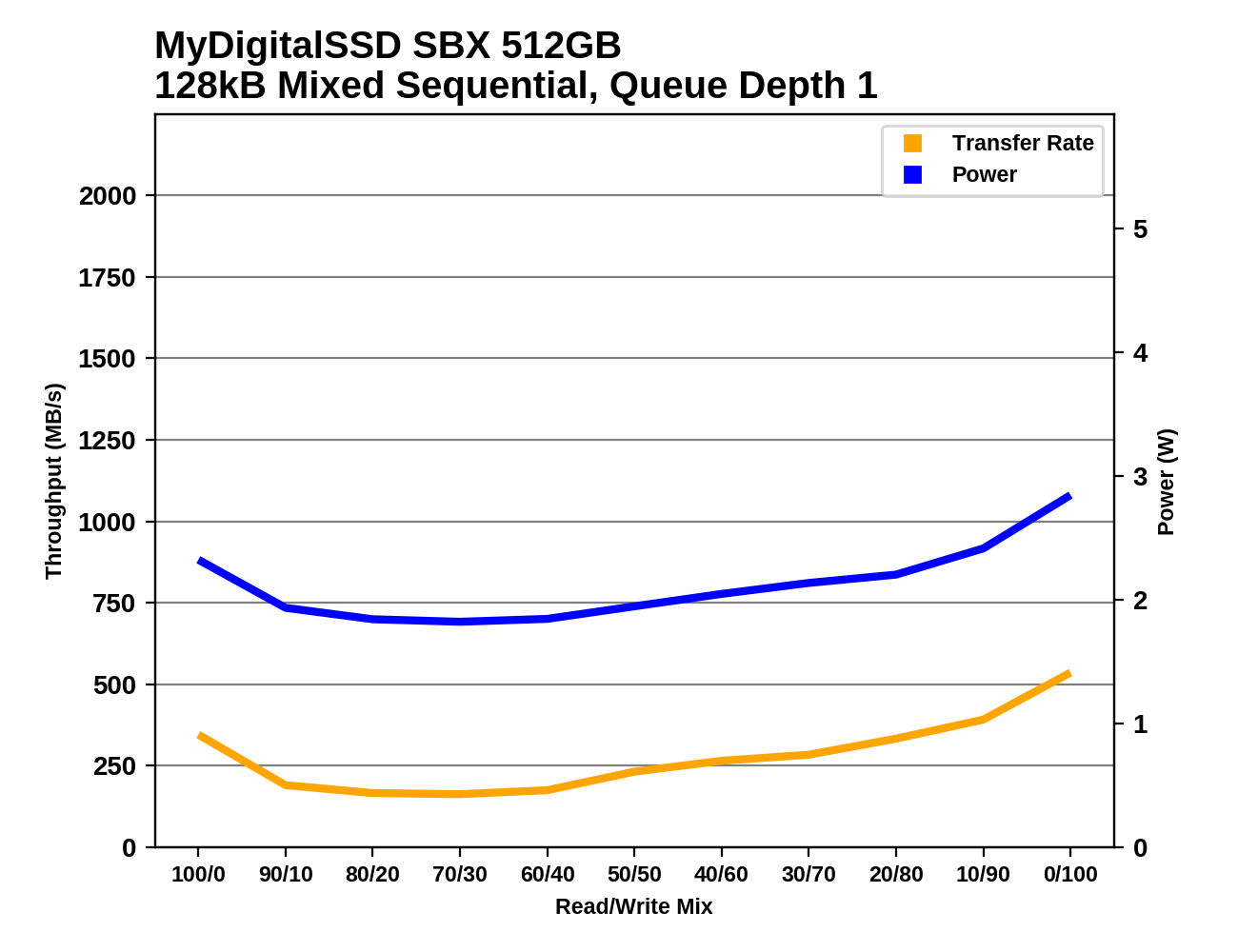 |
|||||||||
The performance of the MyDigitalSSD SBX drops during the early phases of the test, reaching a minimum with a relatively read-heavy workload before recovering slightly. In the second half of the test as the workload is more write-heavy, the 512GB SBX picks up speed but the 256GB and 128GB models stay at a roughly constant performance level. The 128GB then drops again in the final phase of the test with a pure write workload.










46 Comments
View All Comments
MajGenRelativity - Tuesday, May 1, 2018 - link
The price premium of lower-end NVMe SSDs forms a big part of their problem in my head. When I build a computer for somebody, I usually use an M.2 SATA SSD if I include an SSD, because SATA SSDs are the cheaper alternative, and most people won't use the performance of an NVMe SSD. If they *do* need the performance of NVMe, I find it a little hard to justify stopping at the low end when they can pay a bit more and bump up the performance by quite a lot. My thoughts are that while products like the SBX are a step in the right direction, they really need to match SATA drives in price to become fully worthwhile.Dribble - Tuesday, May 1, 2018 - link
The other thing they have going for them is size. I can see a cheap nvme being used quite a bit in mid range laptops that came with a SATA disk but have a spare nvme slot. For desktops not only does the drive sit flush with the motherboard mostly, but it requires no cabling and no hd cage to put it in. I could see myself getting one as a second drive - it's not like I'd really be able to tell it's any slower then a high end drive for standard desktop usage.Dribble - Tuesday, May 1, 2018 - link
Ah didn't read the previous comment carefully enough "M2 SATA SSD" not "SATA SSD", never mind.MajGenRelativity - Tuesday, May 1, 2018 - link
Yeah. I can see 2.5" SATA going away entirely / being replaced by 2.5" U.2, but M.2 SATA still has a place for meeek2121 - Wednesday, May 2, 2018 - link
My current machine no longer has any type of SATA drive in it. I have a single 1TB Samsung 960 EVO. I thought about going going for the pro or a 2 TB EVO, but this fits my needs perfectly. Now if we could just get a mini-itx threadripper board... ;)MajGenRelativity - Thursday, May 3, 2018 - link
For me, I need bulk storage, so SATA isn't going away any time soon. However, I don't think Mini-ITX Threadripper will happen, as the socket is too bigRatman6161 - Monday, May 7, 2018 - link
Price wise, for a lot of people in your situation, you could get the 500 GB 960 EVO for $200 and also the 1 TB MX500 for $249. That would give you a total of 1.5 TB for the price of a 1 TB 960EVO. Then EVO could then be used for OS and programs with some data while the cheap but still pretty good MX500 could provide the big storage.gglaw - Saturday, May 19, 2018 - link
The popular budget Micron 3D TLC 2TB drives are on sale all the time from $280-$300 range. They don't have much marketing or even a fancy name associated with them, come in a bare OEM type box but the few reviews out are all favorable. I have one as a secondary storage drive with a 960 EVO 500GB boot drive but tbh when I moved my Steam library over to it, I can't even tell the difference in performance between it and the NVMe EVO.https://www.amazon.com/Micron-1100-SATA-2-5-inch-M...
that's the drive but it goes on sale lower than that pretty much every week.
wumpus - Tuesday, May 1, 2018 - link
Why eat the slot? Do your clients get grumpy if they see and "old fashioned" 2.5" drive? I'd rather leave the M.2 slot waiting for a card that really needs it, and still have the SATA drive connected.MajGenRelativity - Tuesday, May 1, 2018 - link
I sell to a variety of clients (I co-own a small business so we cover all sorts), and usually they don't have enough technical knowledge to know the difference between a 2.5" drive and M.2. I use the M.2 slot because it allows me to either disconnect the SATA cable (for a modular PSU), or tuck it out of the way to increase airflow. Most of my customers won't need the performance boost of upgrading to an NVMe drive, so it hasn't been a problem before. In the cases where that is a viable upgrade path, I discuss it ahead of time, and do use a 2.5" drive in situations where necessary/desired.